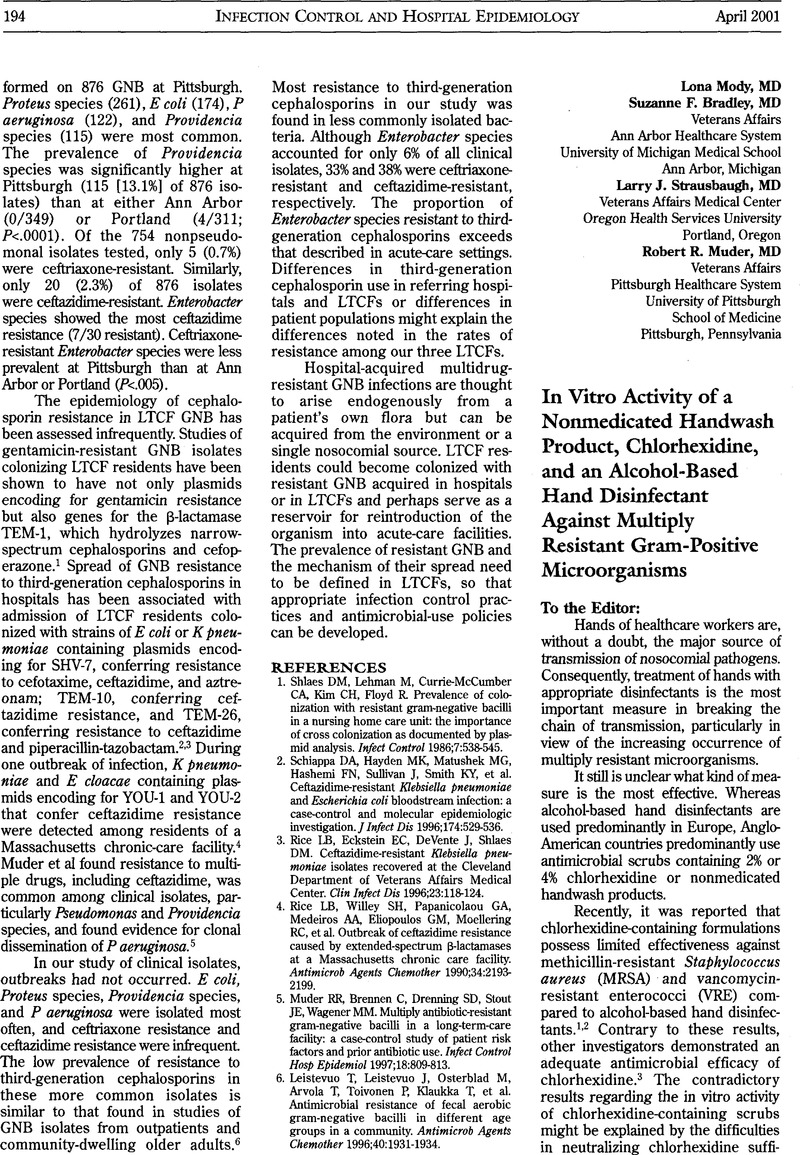Crossref Citations
This article has been cited by the following publications. This list is generated based on data provided by Crossref.
Harbarth, Stephan
2001.
Nosocomial transmission of antibiotic-resistant microorganisms.
Current Opinion in Infectious Diseases,
Vol. 14,
Issue. 4,
p.
437.
Brooks, Steven E.
Walczak, Mary A.
Hameed, Rizwanullah
and
Coonan, Patrick
2002.
Chlorhexidine Resistance in Antibiotic-Resistant Bacteria Isolated From the Surfaces of Dispensers of Soap Containing Chlorhexidine.
Infection Control & Hospital Epidemiology,
Vol. 23,
Issue. 11,
p.
692.
Tammelin, Ann
Klötz, Fia
Hambræus, Anna
Ståhle, Elisabeth
and
Ransjö, Ulrika
2003.
Nasal and Hand Carriage ofStaphylococcus aureusin Staff at a Department for Thoracic and Cardiovascular Surgery: Endogenous or Exogenous Source?.
Infection Control & Hospital Epidemiology,
Vol. 24,
Issue. 9,
p.
686.
Picheansathian, Wilawan
2004.
A systematic review on the effectiveness of alcohol‐based solutions for hand hygiene.
International Journal of Nursing Practice,
Vol. 10,
Issue. 1,
p.
3.
Picheansathian, Wilawan
2004.
Effectiveness of Alcohol-based solutions for Hand Hygiene: A Systematic Review.
JBI Library of Systematic Reviews,
Vol. 2,
Issue. 9,
p.
1.
Picheansathian, Wilawan
2004.
Effectiveness of Alcohol-based solutions for Hand Hygiene: A Systematic Review.
JBI Database of Systematic Reviews and Implementation Reports,
Vol. 2,
Issue. 9,
p.
1.
Kampf, Günter
and
Kramer, Axel
2004.
Epidemiologic Background of Hand Hygiene and Evaluation of the Most Important Agents for Scrubs and Rubs.
Clinical Microbiology Reviews,
Vol. 17,
Issue. 4,
p.
863.
Goetz, M.-L
2004.
Les solutions hydroalcooliques: indications, avantages et inconvénients.
Médecine et Maladies Infectieuses,
Vol. 34,
Issue. ,
p.
S124.
Gaonkar, T.A.
Geraldo, I.
Caraos, L.
and
Modak, S.M.
2005.
An alcohol hand rub containing a synergistic combination of an emollient and preservatives: prolonged activity against transient pathogens.
Journal of Hospital Infection,
Vol. 59,
Issue. 1,
p.
12.
Gordin, Fred M.
Schultz, Maureen E.
Huber, Ruth A
and
Gill, Janet A.
2005.
Reduction in Nosocomial Transmission of Drug-Resistant Bacteria After Introduction of an Alcohol-Based Handrub.
Infection Control & Hospital Epidemiology,
Vol. 26,
Issue. 7,
p.
650.
Brill, Florian
Goroncy-Bermes, Peter
and
Sand, Wolfgang
2006.
Influence of growth media on the sensitivity of Staphylococcus aureus and Pseudomonas aeruginosa to cationic biocides.
International Journal of Hygiene and Environmental Health,
Vol. 209,
Issue. 1,
p.
89.
Chen, Li-Kuang
Liu, Yu-Lin
Hu, Anren
Chang, Kai-Chih
Lin, Nien-Tsung
Lai, Meng-Jiun
and
Tseng, Chun-Chieh
2013.
Potential of bacteriophage ΦAB2 as an environmental biocontrol agent for the control of multidrug-resistant Acinetobacter baumannii.
BMC Microbiology,
Vol. 13,
Issue. 1,
Chemaly, Roy F.
Simmons, Sarah
Dale, Charles
Ghantoji, Shashank S.
Rodriguez, Maria
Gubb, Julie
Stachowiak, Julie
and
Stibich, Mark
2014.
The role of the healthcare environment in the spread of multidrug-resistant organisms: update on current best practices for containment.
Therapeutic Advances in Infectious Disease,
Vol. 2,
Issue. 3-4,
p.
79.





